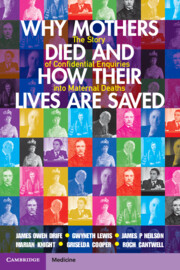 Why Mothers Died and How their Lives are Saved
Why Mothers Died and How their Lives are Saved Published online by Cambridge University Press: 05 April 2023
Lying in after giving birth has a long tradition but carries a risk of thrombosis. Blood clots form in leg veins and may embolise to the lungs, causing death. Early CEMD Reports did not recognise the benefits of early ambulation but divided thromboembolism deaths into three groups – during pregnancy, after vaginal delivery and after caesarean section. The Reports identified risk factors including age, obesity and caesarean section, and found that warning symptoms were being ignored. Shorter hospital stay reduced the number of deaths after vaginal birth. Caesarean section rates rose and an Enquiry into Perioperative Deaths (modelled on the CEMD) revealed the risk factors for post-operative thromboembolism. An 1995 an RCOG report advised on preventive measures including anticoagulants, previously avoided lest they cause bleeding. A sharp fall in deaths after caesarean section followed in 1997-9. By then thromboembolism was the leading Direct cause of maternal death and the benefits of guidelines had become clear. In 2004 the RCOG published a guideline on thromboprophylaxis in pregnancy and in 2006-8 thomboembolism fell to third place among causes of Direct death.
To save this book to your Kindle, first ensure [email protected] is added to your Approved Personal Document E-mail List under your Personal Document Settings on the Manage Your Content and Devices page of your Amazon account. Then enter the ‘name’ part of your Kindle email address below. Find out more about saving to your Kindle.
Note you can select to save to either the @free.kindle.com or @kindle.com variations. ‘@free.kindle.com’ emails are free but can only be saved to your device when it is connected to wi-fi. ‘@kindle.com’ emails can be delivered even when you are not connected to wi-fi, but note that service fees apply.
Find out more about the Kindle Personal Document Service.
To save content items to your account, please confirm that you agree to abide by our usage policies. If this is the first time you use this feature, you will be asked to authorise Cambridge Core to connect with your account. Find out more about saving content to Dropbox.
To save content items to your account, please confirm that you agree to abide by our usage policies. If this is the first time you use this feature, you will be asked to authorise Cambridge Core to connect with your account. Find out more about saving content to Google Drive.